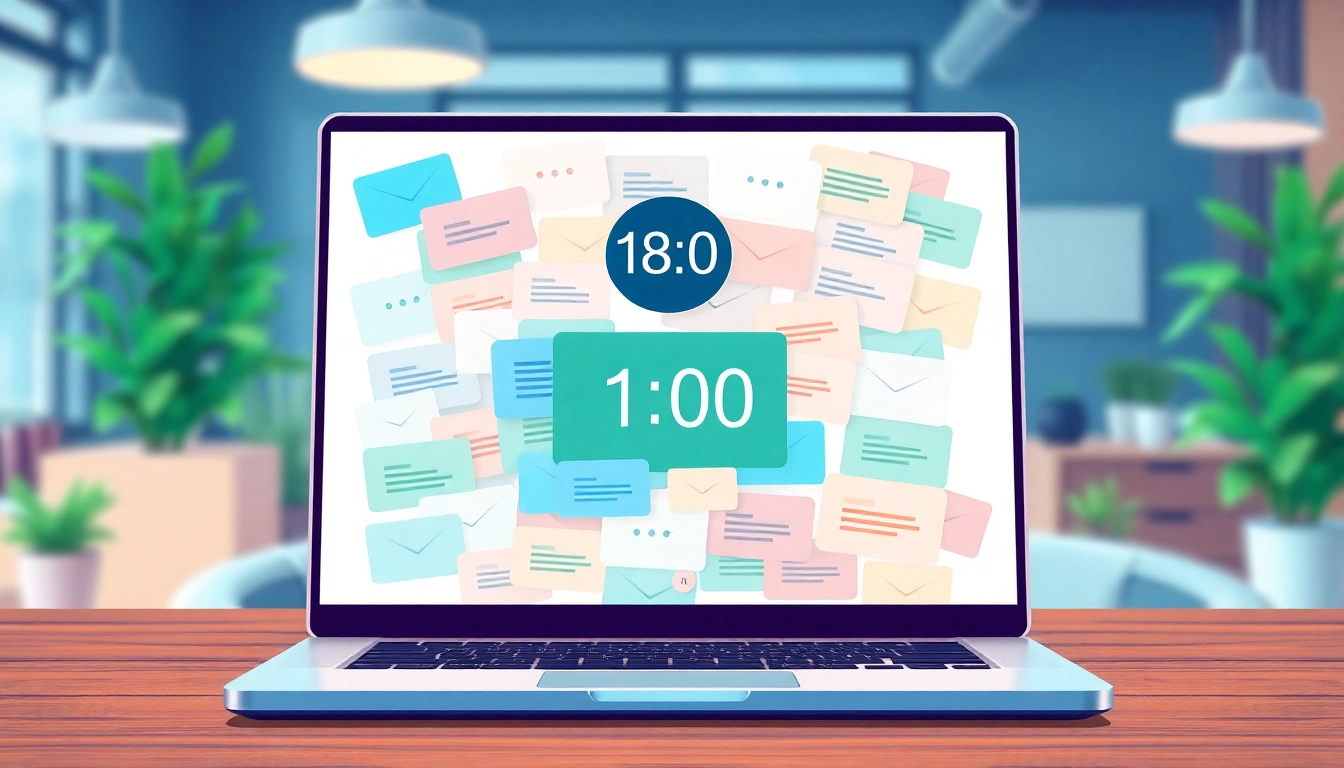Understanding 10 Minute Mail
What is 10 Minute Mail?
In an increasingly digital world, protecting personal information has never been more important. Among various tools designed to enhance privacy, 10 minute mail stands out as a convenient option. Essentially, 10 minute mail is a temporary email service that provides users with an email address that expires after a brief duration—typically ten minutes. This allows individuals to receive confirmation emails, verification codes, or any other correspondence without exposing their real email addresses. This anonymity is crucial for users who frequently encounter sites requiring registration or verification while prioritizing their privacy.
How Does 10 Minute Mail Work?
Using 10 minute mail is remarkably simple and straightforward. Users can generate an email address at the click of a button. Once the temporary address is created, it can receive emails for a limited period (10 minutes). After this timeframe, the email address and all associated messages are permanently deleted. This process ensures that users can utilize the features of a typical email address—like receiving verification codes—without the risk of spam or having their personal information harvested by malicious entities.
The mechanism is straightforward: the user visits a website offering 10 minute mail services, clicks to receive a new temporary email address, and then utilizes it in the required field of a registration or confirmation form. The emails sent to this address can be viewed on the same webpage, allowing the user to complete the verification process instantly.
Benefits of Using 10 Minute Mail
The advantages of using 10 minute mail are numerous and significant, especially for internet users who value their privacy. Firstly, it greatly enhances security by minimizing the chances of spam and phishing attempts. Results show that many online attackers rely on collecting email addresses through registrations, which can lead to data breaches. With a temporary email, users can shield their real addresses from such threats.
Moreover, using 10 minute mail helps in keeping one’s primary inbox organized and free from clutter. By directing potential promotional emails to a temporary address, users can maintain their main email space for essential correspondence, ensuring a more efficient and stress-free management of emails. Additionally, this service can help users bypass certain registration requirements, enabling quick access to content without long-term commitment.
Common Use Cases for 10 Minute Mail
Signing Up for Online Services
One of the most prevalent use cases for 10 minute mail is signing up for online services. Many platforms require an email for verification, but users often do not wish to receive ongoing communication from those services. By using a temporary email, users can complete the sign-up process without any future obligations or spam. This is particularly helpful for websites that promote free trials or services that may require payment information.
Additionally, users can take advantage of multiple trials without the fear of creating multiple permanent accounts. This use case emphasizes the flexibility that temporary email solutions provide; invariably, users can test services, review functionalities, and decide to engage further without the commitment associated with real email registrations.
Protecting Your Privacy
In the digital age, privacy and security have become paramount concerns. Whether one is participating in forums, commenting on blog posts, or registering for newsletters, the potential risks of exposing personal information are ever-present. 10 minute mail serves as an effective tool for safeguarding personal data against potential data breaches. Individuals concerned about their online footprint can use a disposable email address to protect their core identity.
This temporary email solution not only helps maintain privacy but also discourages unsolicited marketing communication. Users can enjoy the benefits of interacting with services and communities without the dread of invasive follow-up marketing tactics associated with traditional email sign-ups.
Avoiding Spam and Promotions
Another significant advantage of utilizing 10 minute mail is the ability to avoid spam and overwhelming promotional content. Upon creating an account or subscribing to a service, the ensuing emails can often become burdensome, cluttering the inbox with irrelevant offers and updates. With 10 minute mail, users can strategically manage which services they want to engage with while keeping their primary inbox free from unwanted messages.
By utilizing disposable emails for one-time interactions or registrations, users can easily discard any subsequent communications without any second thoughts. This capability fosters a streamlined and organized approach to online correspondence, allowing for heightened productivity and reduced digital stress.
How to Create and Use 10 Minute Mail
Step-by-Step Guide to Accessing 10 Minute Mail
Creating a temporary email address with 10 minute mail is extremely user-friendly. Here’s a simple step-by-step guide:
- Visit a website that offers 10 minute mail services.
- On the homepage, typically, you will see an option to generate a temporary email immediately without any required sign-up.
- Click the button to generate your temporary email address.
- Copy the newly created email address and use it for the required registration or sign-up form.
- Check for incoming emails on the same page; open them to retrieve any verification codes or information necessary.
- Note that you have approximately ten minutes to utilize the email before it expires.
This quick process ensures easy access to temporary email addresses, enhancing the user experience and promoting secure online interactions.
Best Practices for Temporary Email Use
While using 10 minute mail can significantly enhance digital privacy, adhering to certain best practices can further maximize its benefits. Here are a few recommendations:
- Use for Non-Critical Services: Reserve temporary emails for services where privacy is of utmost importance but that do not relate to critical accounts.
- Limit Use for Sensitive Transactions: Avoid using disposable emails for services requiring sensitive information such as bank details or personal identification.
- Monitor Time Limits: Be aware of the time limit associated with the email address. Ensuring action is taken promptly can prevent missed communications.
- Clear Communication Purpose: Understand your intent behind using a temporary email to prevent unneeded complexities. This includes determining if the email is for a singular use or for trial purposes.
Following these best practices helps prevent potential issues with using temporary email services and enhances overall digital security.
Common Mistakes to Avoid with 10 Minute Mail
While utilizing 10 minute mail is easy, users may encounter common pitfalls that could impact their effectiveness or security. Here are some mistakes to avoid:
- Over-reliance on Disposal: Some users may overly depend on temporary emails without recognizing that they are not as secure as permanent accounts.
- Neglecting to Verify: Users often forget to check their temporary inbox before the timer runs out, losing important confirmation emails.
- Using for Long-term Accounts: Establishing long-term accounts with temporary emails may hinder future access if you need to retrieve information.
- Failing to Review Service Terms: It’s crucial to understand the terms and conditions of the services used with temporary emails, as this will avoid potential pitfalls.
Avoiding these mistakes will ensure a smoother experience when utilizing 10 minute mail services.
Comparing 10 Minute Mail with Other Services
10 Minute Mail vs. Traditional Email Accounts
When contrasting 10 minute mail with traditional email accounts, several fundamental differences emerge. Primarily, traditional email accounts are designed for ongoing use and often require personal information at sign-up, while 10 minute mail allows for anonymous and transient use without the need for long-term commitments. Users of traditional email accounts typically receive extensive promotional and transactional correspondence, whereas 10 minute mail serves a niche environment of temporary communications.
This distinction emphasizes the security and simplicity of 10 minute mail. In situations where temporary engagements are sufficient, opting for disposable emails saves time and mitigates the risk of spam bombarding one’s primary inbox.
10 Minute Mail vs. Other Temporary Email Services
10 minute mail is one of many temporary email solutions available online. However, it differentiates itself through its quick disposable nature, specifically lasting only ten minutes for its active duration. Other temporary email services may offer longer lifespans or various features but can lack the efficiency and rapid usage context that 10 minute mail promotes.
Furthermore, despite its simplicity, 10 minute mail maintains a dedicated user base due to its straightforward mechanism, emphasizing the balance between user experience and security.
Unique Features of 10 Minute Mail
Several unique features set 10 minute mail apart from other email solutions, emphasizing its effectiveness in providing transient email addresses. Key features include:
- Instant Creation: The ability to generate an email address instantly without any registration process allows for quick access.
- Automatic Expiry: Addresses only exist for ten minutes, removing the lingering threat of potential misuse.
- Email Viewing Interface: Users can read incoming emails directly on the generating website, simplifying the validation process.
These features enhance the convenience of 10 minute mail, adding layers of efficiency and security for everyday online interactions.
Maximizing the Effectiveness of 10 Minute Mail
Integrating 10 Minute Mail into Your Digital Workflow
To effectively maximize the utility of 10 minute mail, integrating it into your daily digital workflow can yield significant benefits. Here’s how:
- Streamline Registrations: Incorporate temporary emails for signing up for newsletters, online resources, and trial services.
- Enhance Privacy Settings: Use 10 minute mail for services or platforms where privacy is paramount, like forums or unfamiliar sites that require personal information.
- Efficient Communication Management: Redirect unwanted promotional emails to temporary addresses to keep your primary email space dedicated to essential correspondence.
This seamless integration can improve workflow efficiency while bolstering privacy during online interactions.
Measuring the Security of Your Temporary Emails
Though temporary emails like 10 minute mail offer enhanced privacy, being aware of their security levels is crucial. Users should employ specific measures like:
- Reviewing Privacy Policies: Familiarize yourself with the terms of service of the 10 minute mail provider to understand the security measures in place.
- Limiting Personal Information: Avoid sending sensitive data through temporary emails, as they may not provide the best protection.
- Regularly Clearing Cache: Engage in privacy hygiene by regularly clearing browser cache after using temporary emails.
Implementing these tactics will enable users to make informed decisions and enhance the security of their temporary email interactions.
Future Trends of Temporary Email Services
As digital privacy becomes increasingly salient, the demand for disposable email services is expected to rise. Anticipated trends can include:
- Increased User Adoption: As concerns about data breaches become more prevalent, more users may adopt temporary emails as a preventive measure.
- Advanced Features: Future services may evolve, offering additional privacy features like enhanced encryption and interaction history.
- Integration with Other Services: Temporary emails may integrate more seamlessly with applications and platforms, allowing for improved user experience and added functionality.
Monitoring these trends can offer insights into how temporary email solutions will evolve to meet the growing demands for online security and privacy.



